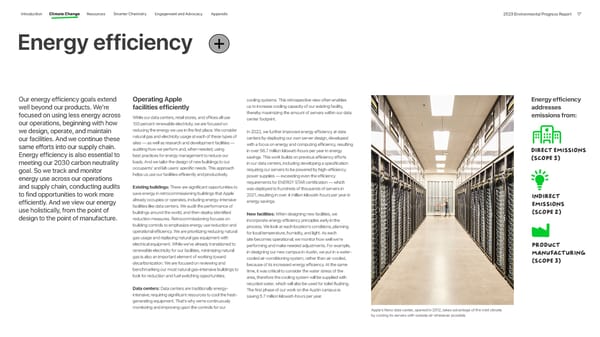Introduction Climate Change Resources Smarter Chemistry Engagement and Advocacy Appendix 2023 Environmental Progress Report 17 Energy efficiency Our energy efficiency goals extend Operating Apple cooling systems. This retrospective view often enables Energy efficiency well beyond our products. We’re facilities efficiently us to increase cooling capacity of our existing facility, addresses focused on using less energy across thereby maximizing the amount of servers within our data emissions from: While our data centers, retail stores, and offices all use center footprint. our operations, beginning with how 100 percent renewable electricity, we are focused on we design, operate, and maintain reducing the energy we use in the first place. We consider In 2022, we further improved energy efficiency at data our facilities. And we continue these natural gas and electricity usage at each of these types of centers by deploying our own server design, developed same efforts into our supply chain. sites — as well as research and development facilities — with a focus on energy and computing efficiency, resulting auditing how we perform and, when needed, using in over 56. 7 m illion kilowatt-hours per year in energy Direct emissions Energy efficiency is also essential to best practices for energy management to reduce our savings. This work builds on previous efficiency efforts (scope 1) meeting our 2030 carbon neutrality loads. And we tailor the design of new buildings to our in our data centers, including developing a specification goal. So we track and monitor occupants’ and lab users’ specific needs. This approach requiring our servers to be powered by high-efficiency energy use across our operations helps us use our facilities efficiently and productively. power supplies — exceeding even the efficiency requirements for ENERGY STAR certification — which and supply chain, conducting audits Existing buildings: There are significant opportunities to was deployed to hundreds of thousands of servers in to find opportunities to work more save energy in retrocommissioning buildings that Apple 2021, resulting in over 4 m illion kilowatt-hours per year in Indirect efficiently. And we view our energy already occupies or operates, including energy-intensive energy savings. emissions use holistically, from the point of facilities like data centers. We audit the performance of buildings around the world, and then deploy identified New facilities: When designing new facilities, we (scope 2) design to the point of manufacture. reduction measures. Retrocommissioning focuses on incorporate energy efficiency principles early in the building controls to emphasize energy use reduction and process. We look at each location’s conditions, planning operational efficiency. We are prioritizing reducing natural for local temperature, humidity, and light. As each gas usage and replacing natural gas equipment with site becomes operational, we monitor how well we’re electrical equipment. While we’ve already transitioned to performing and make needed adjustments. For example, Product renewable electricity for our facilities, minimizing natural in designing our new campus in Austin, we put in a water- manufacturing gas is also an important element of working toward cooled air-conditioning system, rather than air-cooled, (scope 3) decarbonization. We are focused on reviewing and because of its increased energy efficiency. At the same benchmarking our most natural gas–intensive buildings to time, it was critical to consider the water stress of the look for reduction and fuel switching opportunities. area, therefore the cooling system will be supplied with recycled water, which will also be used for toilet flushing. Data centers: Data centers are traditionally energy- The first phase of our work on the Austin campus is intensive, requiring significant resources to cool the heat- saving 5. 7 m illion kilowatt-hours per year. generating equipment. That’s why we’re continuously monitoring and improving upon the controls for our Apple’s Reno data center, opened in 2012, takes advantage of the mild climate by cooling its servers with outside air whenever possible.
 Apple Environmental | Immersive Page 16 Page 18
Apple Environmental | Immersive Page 16 Page 18